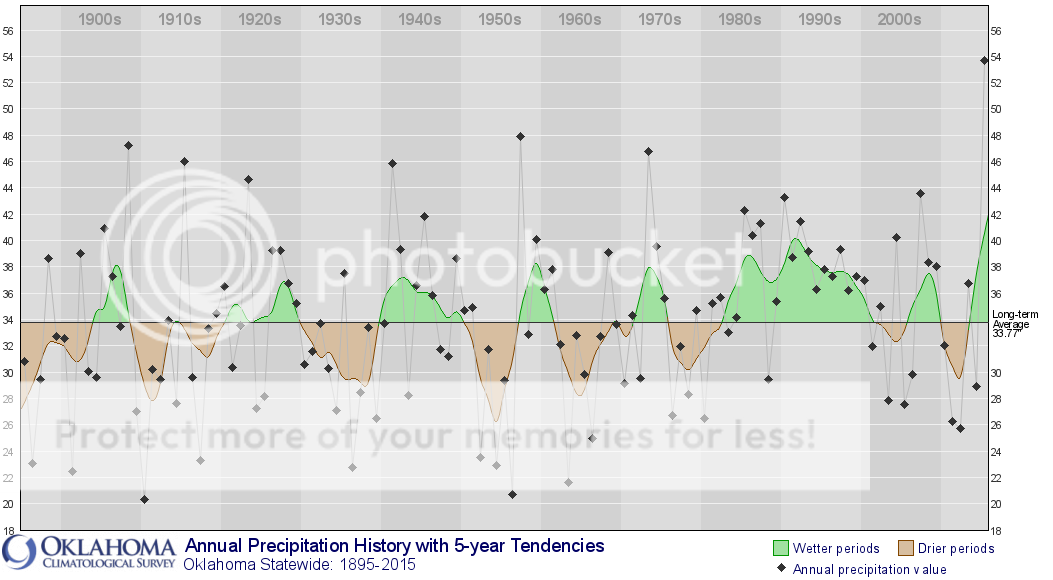Unfortunately, many managers of free-ranging deer populations focus on and are distracted by superficial management practices such as food plots, mineral supplementation, buck culling, breeder bucks, stocking better genetics, harvesting certain age-classes of bucks, etc. Many of these practices are appropriate in penned-deer situations, but inefficiencies exist and limited progress occurs when managers of free-ranging deer focus on superficial issues rather than developing and maintaining excellent deer habitat, adequate doe harvest and conservative buck harvest.
It is important to understand the historical context of the 100 mile radius area in the southern great plains to better understand the article. This area saw much homesteading activity prior to 1950. Homesteading activity (fire, thinning and clearing for fuel wood, plowing, grazing etc) begets disturbance which creates excellent wildlife habitat due to the increase in plant diversity at ground level. Increasing urban labor opportunities and improved urban living conditions after 1950 saw people leaving the farm to live and work in the cities. Continuous grazing practices leading to overgrazing/ diversity loss and excess tillage which degraded soil finally took their toll on land productivity. Less time and effort were available for farm tasks which keep brush/invasive plant encroachment in check (ie livestock grazing declined,fuel wood was replaced with alternate energy, commercial farming began etc) and degraded lands still carried low value. During the 80s to present wide scale brush encroachment has occurred in areas which are traditionally non-hardwood ecoregions.....SCS recommended replacing degraded range with tame perennial forages such as Bermuda and fescue, eastern red cedar and other invasive plant encroachment occurred in western native range land, fire suppression and lack of fuel wood clearing in the east saw the oak savannah replaced with closed canopies of elm, cedar, juniper, hickory and other low value species, and land prices have inflated so much that it is hard for the average man to restore land productivity economically. Considering all of that in whole, the productivity of a whole ecosystem has become degraded Since 1980, brush control and suppression has been a huge issue for many acres simply to restore land functionality and productivity. During the 80s there was a large scale spurt of brush control (aerial timber spraying) in the east which has since waned excepting some large operations, ERC removal in the west is now a hot topic, and prescribed fire use is now a right protected by law. Some properties are now being improved but a large proportion remain abandoned, non-disturbed, and in a steady state of habitat quality decline. There is little choice other than to preserve this ecosystem through regenerative land efforts.
Folks, all of that history is nice to know but it doesn't change the fact that we are dealing presently with a degraded low value land resource but the actual cost of land and land improvement are high. That fact isn't going to change unless landscape and regional scale efforts are undertaken to restore soil function, watershed function, and provide the diverse habitat which wildlife require by using economical tools.
The most economical tools ($/ac/hr) for restoration are prescribed fire, tree thinning/removal, and planned livestock grazing. All of those tools are socially acceptable while still debated at times. "Quote, D
eveloping and maintaining excellent deer habitat, adequate doe harvest and conservative buck harvest"...... are economical practices we must employ and train our children to use in the future! Do the aforementioned goals not fall in line with restoration of degraded land?...economically?....socially?...ecologically?
What tasks are being taught and promoted to many average income land managers? "Quote, Unfortunately, many managers of free-ranging deer populations focus on and are distracted by superficial management practices such as food plots, mineral supplementation, buck culling, breeder bucks, stocking better genetics, harvesting certain age-classes of bucks, etc." Please tell me how any of the afore mentioned tasks/tools are going to restore function of a region with degraded land and soil?....economically?....socially? They won't....each fail miserably socially, economically and ecologically!
The main problem is in our mind....many cannot separate the important from the unimportant! Do we need 'tenets of QDM' or do we need 'tenets of common sense'?
In spite of degrading habitat conditions, OK saw a boom in deer populations from the late 80s through late 90s. Why was that? Was is because of QDM?....conservation efforts?....crackdown on poaching/illegal activity?....technology?...increased fawn predator trapping?...wildlife food plots?....mineral supplements?....buck culling?....new deer genetics?....all those combined? I think it is much simpler and due to one primary undeniable fact...the deer boom in OK paralleled a historic climatic shift of above average statewide rainfall from about 1984 to 2002....that is the LONGEST wet period ever recorded for the majority of that 100 mile radius area!

Here is the link for above pic...see for yourself:
http://climate.ok.gov/index.php/cli...l_statewide/CD00/prcp/Annual/oklahoma_climate
What are the major consequences of above average rainfall in the southern great plains?...1) increased animal numbers and carrying capacity, and 2) increased rate of brush encroachment with loss of herbaceous plant diversity!
Is it not reasonable to believe the next deer DOOM will be the opposite of conditions for a BOOM? 1) too much brush present with too little herbaceous plant diversity and 2) too many animals for the carrying capacity? Do we now already see that very thing in other parts of the country?
So what is really important to sustain increased animal numbers and habitat quality in the future given unknown amounts of dry and wet periods? Restoring a native ecosystem which is resilient and resistant to climatic stress....through 1) decreasing brush encroachment rate to increase native plant diversity, and 2) keeping the female part of the herd in balance with climatic trend! Have fun....shoot whatever buck you want....just don't let greed and bragging rights make you shoot too many! Very simple management tenets!
Folks, focus on the 'important' for your ecosystem not the 'unimportant'.....teach your offspring the same! Each ecosystem differs...your's may differ from the article....that article covers about 3-4 ecosystems within 100 mile radius which have a few issues in common!
+

